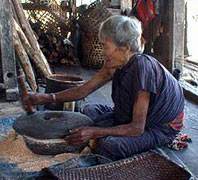 |
 |
Bhutan
Information |
|
 |
Bhutan
Information |
|
|
|
 |
|
Bhutan's Health
|
 |
 |
| Modern
healthcare was introduced in Bhutan in the 1960s. However careful attention
had always been given to traditional practice and the people's perception
of illness. This has ensured that the modern healthcare services and indigenous
medical services develop simultaneously.
Herbal-based,
traditional medicine is well established and integrated into the general
health services and remains a popular form of healthcare. |
|
Access
to traditional medicine in the country has been greatly increased with
31 traditional Drungtshos (Doctors) providing indigenous medical services
in all Dzongkhags (Districts). Traditional medicine continues to hold an
important place in the formal healthcare system as it not only adds an
important dimension to the country's system of healthcare, but also provides
an alternative form of healthcare.
An
integrated healthcare delivery system was foreseen as an effective strategy
to reach the scattered population in Bhutan's rugged terrain. The declaration
of Alma Ata in 1978 adopting a primary healthcare approach to achieve 'Health
for All' has also served accelerate health service development in this
direction.
The
government has maintained a system of complete free healthcare for not
only the Bhutanese citizens but also all those who reside in the country.
In 1961 there was hardly any modern facility in Bhutan. Today, the country
has more than 29 hospitals, 160 Basic Health Units and a 90 percent health
coverage with basic services. The health status of the population has improved
markedly, especially during the last 10 years. National surveys conducted
in 1984, 1994, and 2000 showed a tremendous increase in the access to safe
drinking water and dramatic decrease in mortality and morbidity. The population
growth rate has been brought down from 3.1 percent in 1994 to 2.5 percent
in 2000.
The
national healthcare delivery system is characterized by the central level
being responsible for the administration, training and major referrals
, and the Districts managing the delivery of basic services to the population
through a network of Districts hospitals, Basic Health Units (BHUs) and
outreach clinics (ORCs).
|




